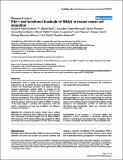Por favor, use este identificador para citar o enlazar a este item:
http://hdl.handle.net/10261/9390COMPARTIR / EXPORTAR:
 SHARE SHARE
 CORE
BASE CORE
BASE
|
|
| Visualizar otros formatos: MARC | Dublin Core | RDF | ORE | MODS | METS | DIDL | DATACITE | |

| Título: | PAI-1 and functional blockade of SNAI1 in breast cancer cell migration |
Autor: | Fabre-Guillevin, Elizabeth; Peinado, Héctor; Moreno-Bueno, Gema CSIC ORCID; Palacios, José; Cano, Amparo CSIC; Barlovatz-Meimon, Georgia | Palabras clave: | Breast cancer Tumoral cell migration Plasminogen Activation (PA) system Snail family SNAI1 Transcriptional repressors Epithelial-mesenchymal transition (EMT) |
Fecha de publicación: | 3-dic-2008 | Editor: | BioMed Central | Citación: | Breast Cancer Research 10: R100 (2008) | Resumen: | [Introduction]: Snail, a family of transcriptional repressors implicated in cell movement, has been correlated with tumour invasion. The Plasminogen Activation (PA) system, including urokinase plasminogen activator (uPA), its receptor and its inhibitor, plasminogen activator inhibitor type 1(PAI-1), also plays a key role in cancer invasion and metastasis, either through proteolytic degradation or by non-proteolytic modulation of cell
adhesion and migration. Thus, Snail and the PA system are both over-expressed in cancer and influence this process. In this study we aimed to determine if the activity of SNAI1 (a member of the Snail family) is correlated with expression of the PA system components and how this correlation can influence tumoural cell migration. [Methods]: We compared the invasive breast cancer cell-line MDA-MB-231 expressing SNAI1 (MDA-mock) with its derived clone expressing a dominant-negative form of SNAI1 (SNAI1-DN). Expression of PA system mRNAs was analysed by cDNA microarrays and real-time quantitative RT-PCR. Wound healing assays were used to determine cell migration. PAI-1 distribution was assessed by immunostaining. [Results]: We demonstrated by both cDNA microarrays and realtime quantitative RT-PCR that the functional blockade of SNAI1 induces a significant decrease of PAI-1 and uPA transcripts. After performing an in vitro wound-healing assay, we observed that SNAI1-DN cells migrate more slowly than MDA-mock cells and in a more collective manner. The blockade of SNAI1 activity resulted in the redistribution of PAI-1 in SNAI1-DN cells decorating large lamellipodia, which are commonly found structures in these cells. [Conclusions]: In the absence of functional SNAI1, the expression of PAI-1 transcripts is decreased, although the protein is redistributed at the leading edge of migrating cells in a manner comparable with that seen in normal epithelial cells. |
Descripción: | 12 pages, 5 figures.-- PMID: 19055748 [PubMed].-- et al. | Versión del editor: | http://dx.doi.org/10.1186/bcr2203 | URI: | http://hdl.handle.net/10261/9390 | DOI: | 10.1186/bcr2203 | ISSN: | 1465-5411 |
| Aparece en las colecciones: | (IIBB) Artículos (IIBM) Artículos |
Ficheros en este ítem:
| Fichero | Descripción | Tamaño | Formato | |
|---|---|---|---|---|
| PAI1_functional_blockade.pdf | Main text | 2,27 MB | Adobe PDF |  Visualizar/Abrir |
| PAI1_functional_blockade_S1.doc | Supplementary data file | 122,5 kB | Microsoft Word | Visualizar/Abrir |
CORE Recommender
PubMed Central
Citations
11
checked on 10-abr-2024
SCOPUSTM
Citations
23
checked on 16-abr-2024
WEB OF SCIENCETM
Citations
23
checked on 28-feb-2024
Page view(s)
406
checked on 18-abr-2024
Download(s)
276
checked on 18-abr-2024
Google ScholarTM
Check
Altmetric
Altmetric
Artículos relacionados:
NOTA: Los ítems de Digital.CSIC están protegidos por copyright, con todos los derechos reservados, a menos que se indique lo contrario.
